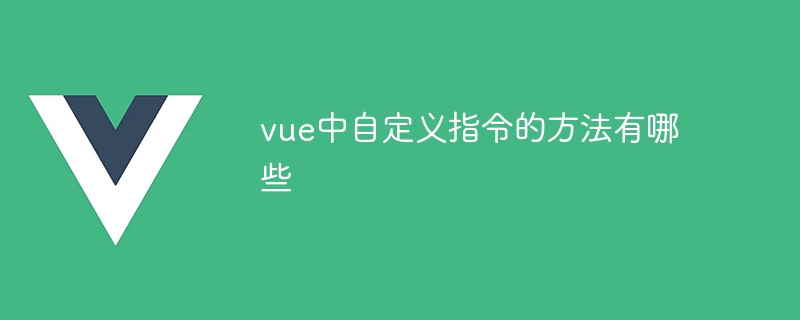What are the ways to customize instructions in vue
Methods to customize Vue instructions include: 1. Global instructions, registered through Vue.directive(); 2. Local instructions, using v-directive instruction syntax in templates; 3. Intra-component instructions, in components registered in the directives option. Each instruction has hook functions such as bind, inserted, update, componentUpdated, and unbind, which are used to execute code during the different life cycles of the instruction.

Methods of custom instructions in Vue
In Vue, you can extend the functions of Vue through custom instructions , to achieve more flexible and reusable code. Here are several ways to create custom directives:
1. Global directive
Vue.directive('my-directive', {
bind(el, binding, vnode) {
// 指令绑定时执行
},
inserted(el, binding, vnode) {
// 指令首次插入 DOM 时执行
},
update(el, binding, vnode, oldVnode) {
// 指令每次更新时执行
},
componentUpdated(el, binding, vnode, oldVnode) {
// 指令所在组件更新后执行
},
unbind(el, binding, vnode) {
// 指令和对应元素解绑时执行
},
});2. Local directive
<template>
<div v-my-directive></div>
</template>
<script>
export default {
directives: {
myDirective: {
bind(el, binding, vnode) {
// 指令绑定时执行
},
// ...其他指令钩子函数
}
}
};
</script>3. In-component instructions
<template>
<template v-my-directive></template>
</template>
<script>
export default {
directives: {
myDirective: {
bind(el, binding, vnode) {
// 指令绑定时执行
},
// ...其他指令钩子函数
}
},
components: {
// ...其他组件注册
MyComponent: {
directives: {
myDirective: {
bind(el, binding, vnode) {
// 指令绑定时执行
},
// ...其他指令钩子函数
}
}
}
}
};
</script>The above is the detailed content of What are the ways to customize instructions in vue. For more information, please follow other related articles on the PHP Chinese website!

Hot AI Tools

Undresser.AI Undress
AI-powered app for creating realistic nude photos

AI Clothes Remover
Online AI tool for removing clothes from photos.

Undress AI Tool
Undress images for free

Clothoff.io
AI clothes remover

Video Face Swap
Swap faces in any video effortlessly with our completely free AI face swap tool!

Hot Article

Hot Tools

Notepad++7.3.1
Easy-to-use and free code editor

SublimeText3 Chinese version
Chinese version, very easy to use

Zend Studio 13.0.1
Powerful PHP integrated development environment

Dreamweaver CS6
Visual web development tools

SublimeText3 Mac version
God-level code editing software (SublimeText3)

Hot Topics
 1672
1672
 14
14
 1428
1428
 52
52
 1332
1332
 25
25
 1276
1276
 29
29
 1256
1256
 24
24
 How to use bootstrap in vue
Apr 07, 2025 pm 11:33 PM
How to use bootstrap in vue
Apr 07, 2025 pm 11:33 PM
Using Bootstrap in Vue.js is divided into five steps: Install Bootstrap. Import Bootstrap in main.js. Use the Bootstrap component directly in the template. Optional: Custom style. Optional: Use plug-ins.
 How to add functions to buttons for vue
Apr 08, 2025 am 08:51 AM
How to add functions to buttons for vue
Apr 08, 2025 am 08:51 AM
You can add a function to the Vue button by binding the button in the HTML template to a method. Define the method and write function logic in the Vue instance.
 How to use watch in vue
Apr 07, 2025 pm 11:36 PM
How to use watch in vue
Apr 07, 2025 pm 11:36 PM
The watch option in Vue.js allows developers to listen for changes in specific data. When the data changes, watch triggers a callback function to perform update views or other tasks. Its configuration options include immediate, which specifies whether to execute a callback immediately, and deep, which specifies whether to recursively listen to changes to objects or arrays.
 How to return to previous page by vue
Apr 07, 2025 pm 11:30 PM
How to return to previous page by vue
Apr 07, 2025 pm 11:30 PM
Vue.js has four methods to return to the previous page: $router.go(-1)$router.back() uses <router-link to="/" component window.history.back(), and the method selection depends on the scene.
 React vs. Vue: Which Framework Does Netflix Use?
Apr 14, 2025 am 12:19 AM
React vs. Vue: Which Framework Does Netflix Use?
Apr 14, 2025 am 12:19 AM
Netflixusesacustomframeworkcalled"Gibbon"builtonReact,notReactorVuedirectly.1)TeamExperience:Choosebasedonfamiliarity.2)ProjectComplexity:Vueforsimplerprojects,Reactforcomplexones.3)CustomizationNeeds:Reactoffersmoreflexibility.4)Ecosystema
 What does vue multi-page development mean?
Apr 07, 2025 pm 11:57 PM
What does vue multi-page development mean?
Apr 07, 2025 pm 11:57 PM
Vue multi-page development is a way to build applications using the Vue.js framework, where the application is divided into separate pages: Code Maintenance: Splitting the application into multiple pages can make the code easier to manage and maintain. Modularity: Each page can be used as a separate module for easy reuse and replacement. Simple routing: Navigation between pages can be managed through simple routing configuration. SEO Optimization: Each page has its own URL, which helps SEO.
 How to use vue traversal
Apr 07, 2025 pm 11:48 PM
How to use vue traversal
Apr 07, 2025 pm 11:48 PM
There are three common methods for Vue.js to traverse arrays and objects: the v-for directive is used to traverse each element and render templates; the v-bind directive can be used with v-for to dynamically set attribute values for each element; and the .map method can convert array elements into new arrays.
 How to reference js file with vue.js
Apr 07, 2025 pm 11:27 PM
How to reference js file with vue.js
Apr 07, 2025 pm 11:27 PM
There are three ways to refer to JS files in Vue.js: directly specify the path using the <script> tag;; dynamic import using the mounted() lifecycle hook; and importing through the Vuex state management library.




